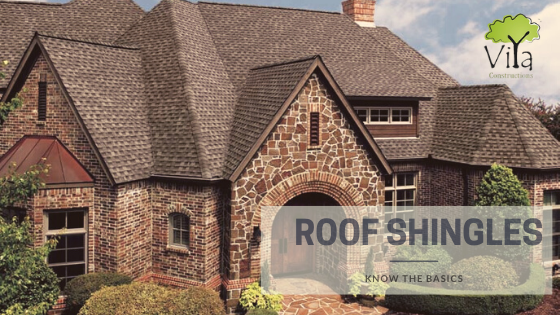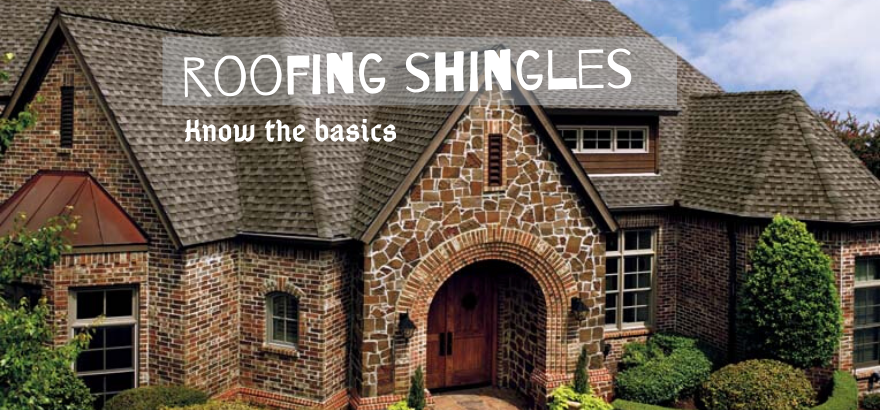Roofing is almost always the first thing to catch your attention when you look at a building. A well laid out roof stands out and adds to the visual impact of any building. It is one of the most important factors that determine the aesthetics of a building.
In addition to aesthetics, roofing plays a key role in protecting the building from natural wear. These factors make the choice of roofing material a very important one.

In our previous posts we have already spoken about the types of roofing suitable for Kerala homes. Clay roof tiles, shingles roofing, concrete roof tiles, polycarbonate and metal sheets are a few of them. Today let’s look at shingles roofing in detail.
What are roofing shingles?
Roofing shingles are individual overlapping elements that cover the roofs of commercial and residential buildings. It acts as a waterproof barrier to protect the structure of the building. They protect the houses from damages caused due to weather changes such as rain, wind etc. Shingles come in many shapes. Commonly available ones are flat and and rectangular in shape.
Why is Roof Shingling Done?
Roofing shingles add to the value of commercial and residential spaces. They enhance the exterior appearance and also provide adequate protection against the varying weather conditions. The colors, patterns and textures all contribute to the final aesthetic look of a building.
Roof Shingling Process
Roof shingling can be done in two ways.
In the first method, the concrete slabs are laid as in a normal sloped roof. The shingles are then glued to the top of the sloped roof. In this method, the shingles act only as an element to enhance the visual appeal of the building and does not serve as a protection against natural weather including rain, sunlight etc.
In the second method, the shingles are part of the protective roofing itself. Here the roof is created as a truss using purlins, rafters and posts. Water resistant Fibre Cement Boards are then laid on top of the truss. The roofing shingles and then laid on top of these cement boards. They are then held in place using nails. The nails fasten the shingles to the Cement board or V board underneath. A silicone roof sealant is used on all corners to prevent leakage.
In both the above methods, the laying of roof shingles start form the bottom edge of the roof and gradually progresses upwards. They are laid in such a fashion that each successive row overlaps the joints below them.
As water runs down the surface of the roof, it flows over each shingle till it reaches the rain-spout. Here, it drips over the edge into the drainage system or to the ground.
Different types of roof shingles
The asphalt shingles also known as “composition shingles” (due to the fact that they are a composite made of materials like fibreglass, asphalt and minerals) are one of the most popular choices for roofing in India. In addition to the variety of choices in colors that it offers, asphalt shingles are easy to install and not very expensive.
Based on the materials used for production, there are two main types of asphalt roof shingles
- Organic – These have base mats that are made of recycled paper, scraps of wood or rags. The base mats are then treated with asphalt and minerals like limestone, slate etc, making it weatherproof. Since the base is organic, such shingles are more prone to damages caused by water and fire.
- Fibreglass – These are manufactured in a more or less similar fashion to organic shingles. They use a fiberglass mat and are therefore more resistant to water and fire. Moreover they contain less asphalt when compared to their organic counterparts.
There are three main types of fibreglass asphalt shingles. They are:-
- 3 Tab Roof Shingles – These are the basic, regular asphalt shingles. They are made of a single layer of asphalt and are very light weight. For the same reason the durability of 3 tab shingles is low. They are also known as strip shingles.
- Laminated or Architectural Roof Shingles – Laminated shingles have a thicker base to which many layers of refined asphalt are adhered, making it much heavier than the 3 tab shingles. They have a thick, three dimensional look and have a high visual appeal. They are also called dimensional shingles.
- Luxury shingles – These are highest quality laminated shingles. In addition to all the advantages of laminated shingles, luxury shingles also look extremely stylish and serve as an additional protection against rough weather.
Some of the other types of shingles found in foreign countries are cedar roof shingles, solar roof shingles, clay roof shingles, metal roof shingles etc. However they have not found much takers in the Indian market.
Advantages of Roof Shingles
- Asphalt shingles are highly affordable and easily available. Moreover, they are extremely lightweight. As a result, they are compatible with most roofing structures.
- Installation and maintenance of the shingles are easy. It is very easy to repair them as well.
- Shingles come in a variety of shapes, sizes and colors. They can therefore be matched to the building based on the aesthetic sense of the architect. They are versatile and are easy to cut, fasten and fit.
- They are quite sturdy and one can even walk on them without damaging the materials. Most brands of shingles offer fire protection also.
Disadvantages of Shingles
- Shingles, especially 3 tab ones, are susceptible to damages caused due to strong winds. Strong winds can uplift the shingles easily, thereby causing damages to residential and commercial complexes.
- Asphalt shingles can curl, crack and become brittle by the heat of the sun.
- Asphalt roof shingles allow transmission of heat into living spaces.
- It is not recommended in places that experience dramatic changes in weather over a short period of time. Such thermal shock will cause damage to the shingles.
- There is a lot of greenhouse emission during the production of asphalt shingles. As a result, asphalt shingles are not very environment friendly. Moreover, they are non recyclable.
Common Mistakes while using Roofing Shingles
- Using new shingles over older ones without removing them. Though it is technically okay to lay new shingles without removing the older ones, we do not recommend it. This is because overlaying shingles make the roof look uneven and heavy. Moreover by overlaying, you wouldn’t be able to detect any leakages in your existing roof.
- Insufficient moisture protection. Build up of water and organic matter may cause moulds to form, thereby reducing the durability and life of the shingles. In Viya work sites, we use Silicone roof sealant to prevent leakage.
- Using shingles on flat roofs. Shingles are designed for sloping roofs. The slower the water moves in a shingle roof, the more chances of trouble.
- Incorrect alignment of the shingles.
- Using the wrong or improper nails patterns to fasten the shingles. It is always advisable to use manufacturers instruction on the number of nails to be used and where to place them.
- Incorrect overhang – the shingle should not hang more than 1.5 inch off the edge of the roof. Shingles with large overhangs are prone to sag. They crack over time and open up the roof to leaks. It could also cause the shingles to fly off during strong winds. Similarly, too little overhang may cause water seepage. Ideally the overhang shouldn’t be over an inch.
Carefully following the manufacturer’s instructions can ensure that shingles are well laid.
Have a look at the roof shingling work done at Viya’s work sites and do give us a call at +91 8138 800 800 for any further queries.


